New York City Department of Environmental Protection Commissioner Emily Lloyd
NYC DEP Deputy Commissioner Angela Licata
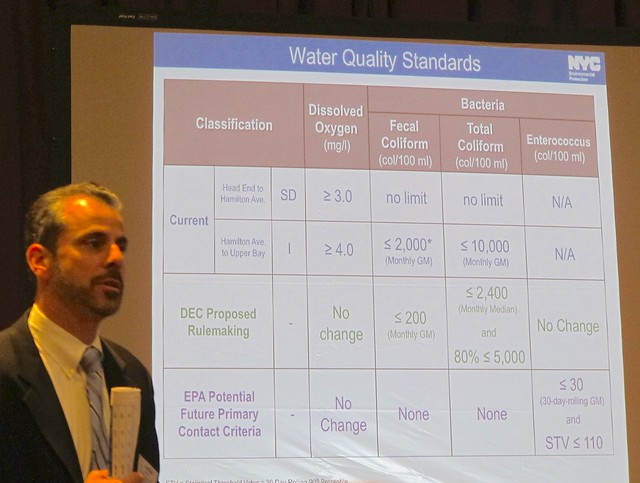
NYC DEP assistant Commissioner Jim Mueller
DEP short list for RH-034 CSO Tank siting
New York City Department Of Environmental Protection (DEP) Commissioner Emily Lloyd came to PS 32 on Hoyt Street on Thursday evening to present the second in a series of meetings related to the Combined Sewer Overflow Long Term Control Plan for the Gowanus Canal.As you may know, the City diverts raw sewage mixed with rainwater directly into the Gowanus Canal and other water bodies during rain events, when our sewage treatment facility is overburdened. This violates the Clean Water Act of 1972.
In addition, the Environmental Protection Agency, as part of its Superfund investigation of the Gowanus Canal, has identified the City as the second largest Potentially Responsible Party (PRP) for discharging "hazardous substance-contaminated untreated sewage" into the canal.
Thursday night's presentation by Commissioner Lloyd focused on the work the City has already completed to address the CSOs and what measures it will implement in the future.
The Gowanus gray infrastructure improvements that have already been undertaken include upgrades to the Gowanus Pumping Station and to the Flushing Tunnel.
The Gowanus Pumping Station was put back into operation in June 2014. According to DEP, the upgrades have increased pumping capacity from 20 to 30 million gallons per day.
Since May 2014, the three pumps at the Flushing Tunnel are operating, which has increased the flow through the tunnel, and improved dissolved oxygen in the water.
The Gowanus Pumping Station was put back into operation in June 2014. According to DEP, the upgrades have increased pumping capacity from 20 to 30 million gallons per day.
Since May 2014, the three pumps at the Flushing Tunnel are operating, which has increased the flow through the tunnel, and improved dissolved oxygen in the water.
Further, the DEP is investing in green infrastructure in Gowanus. So far the agency has built 18 bioswales, has installed porous pavement installation at 4th Street and 5th Avenue, installed a porous playground surface at PS 261. The Agency has provided a grant towards the Gil Hodges Community Garden's storm water management system. 90 more bioswales and 2 storm water green streets are currently under construction.
Commissioner Lloyd also spoke about the location of two CSO retention tanks that the EPA is requiring the City to construct in order to protect its remedy for the Gowanus Canal. Construction of these retention tanks is an important part of the remedial design. As per the EPA, the tanks are "combined sewer overflow (CSO) control measures for the upper reach of the Canal to significantly reduce overall contaminated solid discharges to the Canal." The retention tanks will retain discharges from two of the largest outfalls in the canal, RH-034 and OH-007 and will reduce the CSO in the canal by 58% to 74%.
According to the Federal Agency,"it is estimated that an 8-million gallon tank and a 4-million gallon tank shall be required to address CSOs from outfalls RH-034 and OH-007, respectively."
Though the EPA had suggested two sites for the retention tanks, the agency was willing to discuss alternative locations. The City has until June 30 to make a final site decision.
Commissioner Lloyd explained: "There are two things the EPA told us we could evaluate: one is the locations for those two tanks, and the other was that we could look at alternative sizes for the tanks if we thought we could achieve the 58% to 74% reduction goal with some alternatives other than the tanks. So we have been looking at those. We are not complete with our evaluation, but we think we are getting close."
Commissioner Lloyd explained: "There are two things the EPA told us we could evaluate: one is the locations for those two tanks, and the other was that we could look at alternative sizes for the tanks if we thought we could achieve the 58% to 74% reduction goal with some alternatives other than the tanks. So we have been looking at those. We are not complete with our evaluation, but we think we are getting close."
DEP is considering two sites for the retention tank for outfall RH-034. The first site are two privately owned lots directly adjacent to the canal between Douglass Street and DeGraw Street. The second location is directly across the street at Thomas Greene Park.
"Between those two sites, we think we are likely to recommend the first site," Commissioner Lloyd told the community. "The reasons for that are emerging. First, because of its proximity to the rest of our infrastructure, it will be more efficient to construct and operate. The second reason is that if we go to the park site, we will need a surface building to manage the mechanics and because of potential storm surges, it can't be low. So we have to go up and we are concerned that it will cover significant portions of the park. This means that during construction of the tank, we would disrupt most of the park."
She added:"We and the Parks Department are extremely concerned and very reluctant to lose that piece of parkland."
Lloyd indicated that even with the cost of acquiring the privately owned sites, it still would be cost effective.
The DEP also looked at two sites for outflow OH-007 in the middle of the canal. The agency seems to have settled on the site known as the 'Salt Lot' near the 5th Street turning basin, which is owned by the Department of Sanitation. "It is likely that that is the one we will recommend to the EPA, unless something turn up in our analysis from now till the end of June that surprises us," Lloyd said.
She added: "There is one other alternative that we are looking at concerning the OH-007 outflow. There is some excess capacity in the sewer system going to Owl's Head [sewer treatment plant], beyond the canal. We are looking if we can divert flow from OH-007 into the sewer lines to Owl's Head."
Mysteriously, the DEP seems to have found so many ways to capture rainwater in and around the Gowanus watershed, that the agency is now trying to reduce the size of the EPA-mandated tanks from
an 8 million gallon tank to a 3.5 or 5.7 million gallon tank at RH-034, and from a 4 million gallon tank at OH-007 to a 1.4 or 2.5 million gallon tank. (see chart above).
Lloyd explained that the smaller tanks, according to DEP calculations would achieve the 58% to 74% CSO reduction mandated by the EPA. "An 8 million gallon tank would achieve 82% reduction, which is above what EPA set as as a goal. We are always looking to see if we can meet targets in the canal at a less costly level."
After the presentation, the community had a chance to ask questions.
Asked if DEP is looking at population projections and the effect of new development on the retention tanks and sewage capacity, Lloyd simply replied: "yes, we are doing population projections in the area."
My question related to the siting of the larger tank at the head of the canal and DEP's preference to locate it on private property instead of placing it on park land that it already owns.
"Have you talked to the owners of the property? Have you negotiated a price? Are they willing to sell? If they do not want to sell, does that mean you need to take the land by eminent domain, which is going to take a long, long time? Is that a delaying tactic by the City?" I asked.
Her answer:
"Yes, we have spoken to them. We know what the fair market value of the land is. Yes, if they are unwilling to sell and that is the selected site, we will proceed to eminent domain. We actually think that this can be expedited and we think that we can accomplish that much quicker than doing the work on the [Thomas Greene] park site."
It will be interesting to see what calculations DEP is using to make the argument that using eminent domain to site the tank at RH-034 is as cost effective and timely as placing it on parkland that it already owns.
One can only imagine what the EPA will think of DEP's suggestion.
The Federal Agency, in its Record of Decision, which represents a blueprint for the cleanup of the Gowanus Canal, had suggested Douglas Greene Park and the pool as the preferred site for the tank.
Asked if DEP is looking at population projections and the effect of new development on the retention tanks and sewage capacity, Lloyd simply replied: "yes, we are doing population projections in the area."
My question related to the siting of the larger tank at the head of the canal and DEP's preference to locate it on private property instead of placing it on park land that it already owns.
"Have you talked to the owners of the property? Have you negotiated a price? Are they willing to sell? If they do not want to sell, does that mean you need to take the land by eminent domain, which is going to take a long, long time? Is that a delaying tactic by the City?" I asked.
Her answer:
"Yes, we have spoken to them. We know what the fair market value of the land is. Yes, if they are unwilling to sell and that is the selected site, we will proceed to eminent domain. We actually think that this can be expedited and we think that we can accomplish that much quicker than doing the work on the [Thomas Greene] park site."
It will be interesting to see what calculations DEP is using to make the argument that using eminent domain to site the tank at RH-034 is as cost effective and timely as placing it on parkland that it already owns.
One can only imagine what the EPA will think of DEP's suggestion.
The Federal Agency, in its Record of Decision, which represents a blueprint for the cleanup of the Gowanus Canal, had suggested Douglas Greene Park and the pool as the preferred site for the tank.
The EPA reasoned that:
- the park is one of the only open pieces of land in this densely populated area.
-the land is already owned by New York City.-Thomas Greene Park was constructed over the former Fulton Municipal Works Manufacturing Plant (MGP), which operated on the site from 1879 to 1929. Today, the land underneath the park is still heavily contaminated with coal tar. Since some of this free liquid tar is moving towards the canal, National, Grid, which bought Brooklyn Union Gas/National Grid in 2006, needs to address the problem. The work will be done under NYS Department of Environmental Conservation supervision.
The EPA logically concluded that constructing the tank under the swimming pool area of the park could be combined with the remediation work.
Recently, the DEC released its proposed Environmental Remediation plan. The primary components of the remedy "are the construction of a sealed wall along the western shoreline of the Gowanus Canal and the removal of any coal tar that accumulates behind it."
They appear to be willing to let National Grid off the hook to clean up the former Fulton site until "an opportunity presents itself". Many wonder if we are missing an opportunity right now, with EPA in charge of a massive remediation. We should be outraged that once again this can is kicked down the road for our children and grandchildren to clean up.
So, there you have it reader, we await the final decision of our city and state and hope that they are fully seizing this opportunity to finally clean up our polluted neighborhood and to cooperate with the EPA. We will know for sure in less than two months.
PS:
I also mentioned the suds that have been covering the Gowanus Canal lately. The problem seems to originate at the top of the canal near the flushing tunnel at Douglass Street. It would appear that the three new pumps which the DEP has installed introduce massive amounts of air and movement into the water, which could be stirring up household soaps and fats, which end up in the Gowanus by way of the CSO outflow right next to the flushing tunnel. The effect has become known to many in the Gowanus community as the 'milkshake' effect.
So, there you have it reader, we await the final decision of our city and state and hope that they are fully seizing this opportunity to finally clean up our polluted neighborhood and to cooperate with the EPA. We will know for sure in less than two months.
PS:
I also mentioned the suds that have been covering the Gowanus Canal lately. The problem seems to originate at the top of the canal near the flushing tunnel at Douglass Street. It would appear that the three new pumps which the DEP has installed introduce massive amounts of air and movement into the water, which could be stirring up household soaps and fats, which end up in the Gowanus by way of the CSO outflow right next to the flushing tunnel. The effect has become known to many in the Gowanus community as the 'milkshake' effect.
Since we have mostly had dry weather this spring, I asked Emily Lloyd if that was an indication that sewage was flowing into the canal even when there were no rain events."Not to give a definitive answer tonight, but we don't think this is from the CSO," Commissioner Lloyd answered. "We really think that it is the aeration coming from Buttermilk Channel. That's a very aerated flow that is coming in, and we think that as it comes in, it churns up. That is our preliminary thought at this point."
Photos illustrating the 'Gowanus milk shake effect" taken a few days ago by Reader Andrew

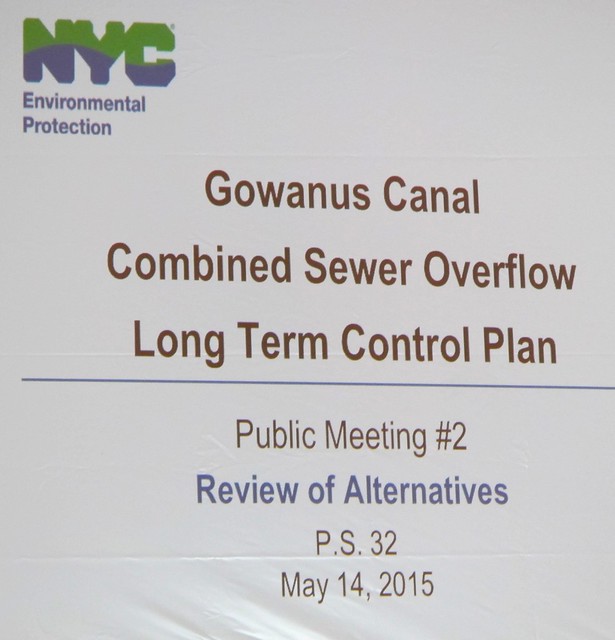
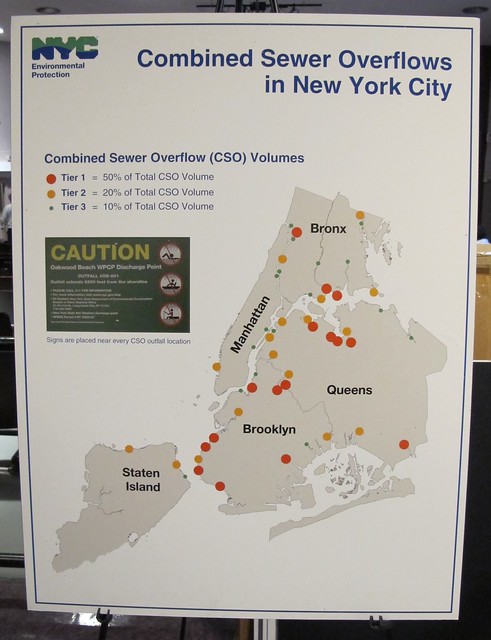
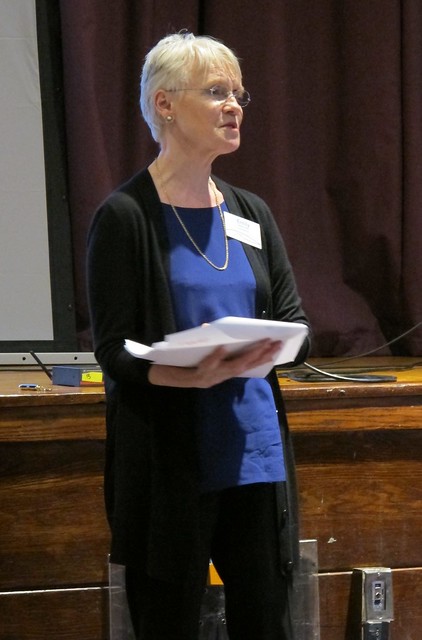

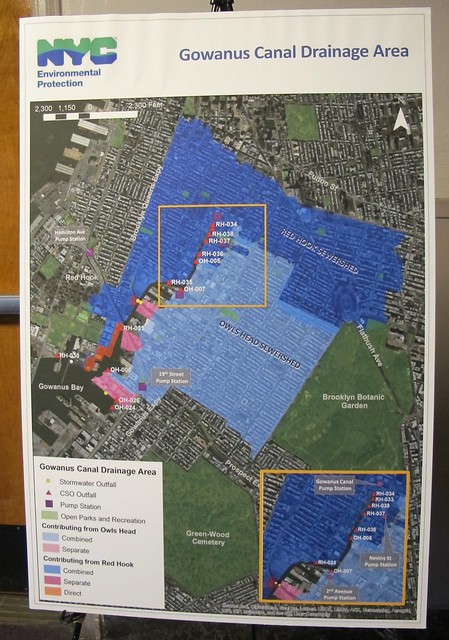
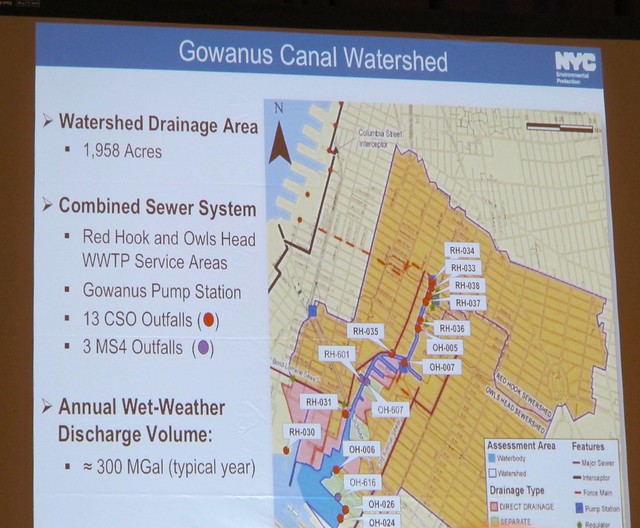
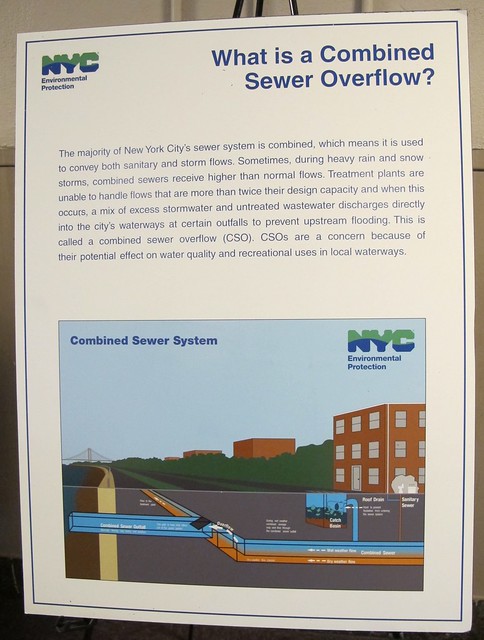
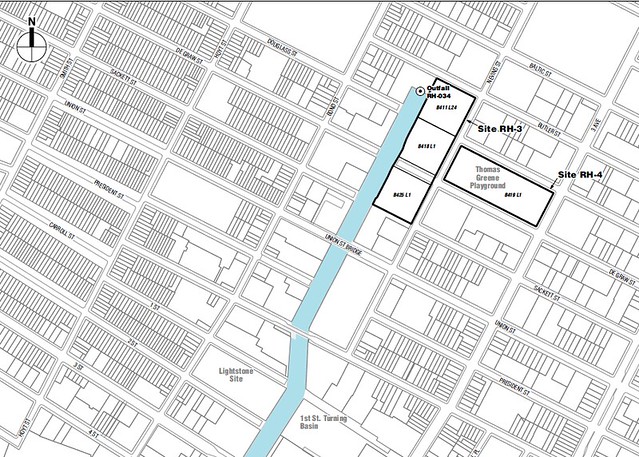
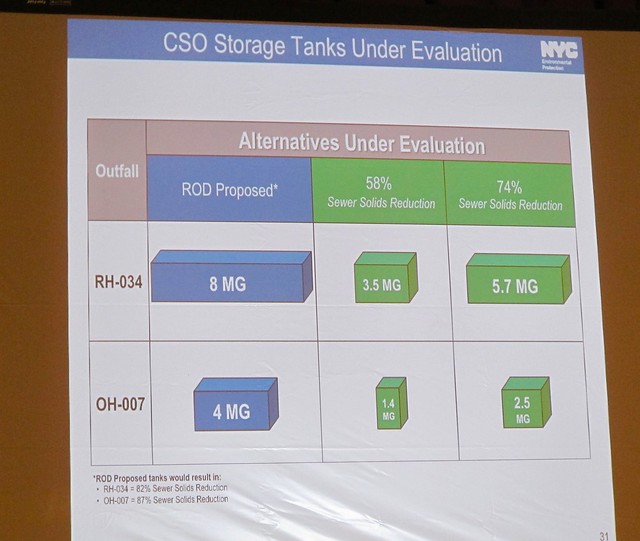
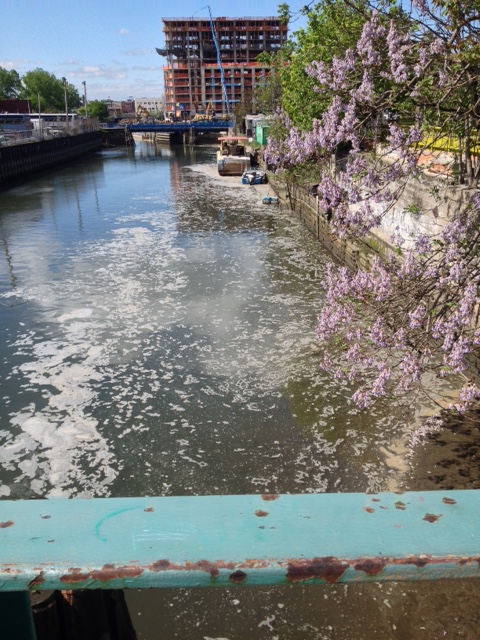
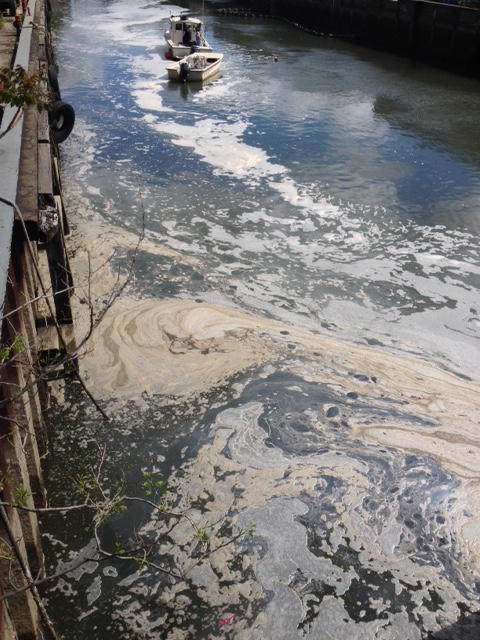






.JPG)

10 comments:
Whole Foods parking lot (not the 3rd St bike lane as parking lot, which scumbags regularly treat it as with Whole Foods and the 78th Pct largely ignoring same) = eminent domain flood basin, now THAT would be beatiful justice!
Yes. I'd like to see the tanks in whole foods also.
Or how about Carroll Park? And why exactly do these tanks look like? Are they above or below ground? Didn't catch that detail.
I think "for reasons that are emerging" is code for "we're going to see what sticks to the wall." They must already be in negotiations with the property owner and the more reasons DEP cites for the private site, the more money the property owner may want.
responding to Anan @ 9:31AM
Someone at the meeting asked the DEP commissioner if they have talked with the property owner(s). The DEP said they have not.
I also attended the meeting. DEP said the new improved Flushing Tunnel has been operational since last spring. And based on their water sampling, the DEP has declared the canal water in compliance with water standards. Yes really!
Everyone should take a walk down to the canal and see for themselves just what the DEP is calling clean water in the Gowanus Canal. And even the water in the turning basins have been declared “clean”. THIS IS REALY THE BEST WATER STANDARD WE ARE GOING TO GET IN GOWANUS?
Which brings up the question, just what are their standards? While everyone is pushing to hold schools to higher standards, maybe we need to refocus that energy on getting our DEP and DEC to improve their standards.
Just to clarify, combined sewer overflows are NOT a violation of the 1972 Clean water act law. there are hundreds of cities across the country that have these EPA approved systems.
CSOs are a problem nationwide and billions are being spent to remediate. Many violate the Clean Water Act which is why many many cities have entered into consent decrees with the EPA.
Thanks for this great write up.
The comment at 6:09 PM is one we hear from the DEP every meeting--that CSO's are everywhere, like we should accept this as normal? Part of the cost of housing so many people together in one small location is managing the imbalance human waste creates in the environment.
And that brings up the big question as the city pushes for more development, why don't developers have to pay for necessary infrastructure that will insure their developments don't through the local ecosystem out of balance with so much human waste? Lightstone, for example contributes nothing to the sewer infrastructure, but more future waste.
There's more here than meets the eye - wondering if the reason for picking the sites for eminent domain if needed is that they'd like to get rid of those businesses so that the neighborhood can continue towards gentrification.
Post a Comment